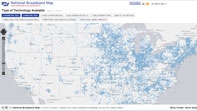New broadband map shows gaps in U.S. coverage

For those who live in urban areas, it’s hard to imagine life without a reliable broadband connection. However, in much of rural America, it’s a fact of life.
Only 60 percent of rural households use broadband Internet service, according to a new report issued by the Department of Commerce. That is 10 percent less than urban households. Overall, 28 percent of Americans do not use the Internet at all.
The report was developed in conjunction with the National Broadband Map that was released as part of a billion-dollar effort to improve Internet access in the United States, particularly in rural areas. The map may be shocking to those who have never viewed the country from the viewpoint of digital “haves” and “have-nots.”
Areas of intense connection include the Eastern Seaboard, the Pacific Northwest, the Bay Area, the Chicago area and the South. The overwhelming majority of the Mountain West and Southwest, as well as inland Northwest and California, appear to be a virtual broadband desert.
President Obama’s administration has given $7.2 billion in stimulus money toward the effort to expand broadband to rural areas. Part of the funding prepared the map, which took five years and $200 million to develop and shows a number of discrepancies in the quality and availability of broadband access between rural and urban communities.
The map was built from 25 million documents that provided information about what kind of connections are available, who the providers are, where the connections are and what speed they operate at.
The website for the map enables a user to analyze the data, browse the map or enter a specific location to see how connected it is. It also requests that users provide missing information, such as an unlisted broadband provider.
The professional video industry's #1 source for news, trends and product and tech information. Sign up below.
“This is like electricity was,” Brian Depew, an assistant director of the Center for Rural Affairs, a nonprofit research group in Lyons, NE, told The New York Times. “This is a critical utility.”
“You often hear people talk about broadband from a business development perspective, but it’s much more significant than that,” Depew added. “This is about whether rural communities are going to participate in our democratic society. If you don’t have effective broadband, you are cut out of things that are really core to who we are as a country.”
Broadband service is currently hit or miss. One rural town might have it, but another town a few miles down the road might not. This is because only a few broadband providers got stimulus money. The tiny Pine Belt Telephone Company applied for the money, hoping to run a fiber-optic line into the small town of Coffeeville, AL, but they were turned down.
“Essentially it comes down to the big, national companies not wanting to invest and the lack of interest in certain areas,” John Nettles, who runs Pine Belt, told the Times. “It’s not much different than the impact the big-box stores have had on rural America and small-town businesses.”
